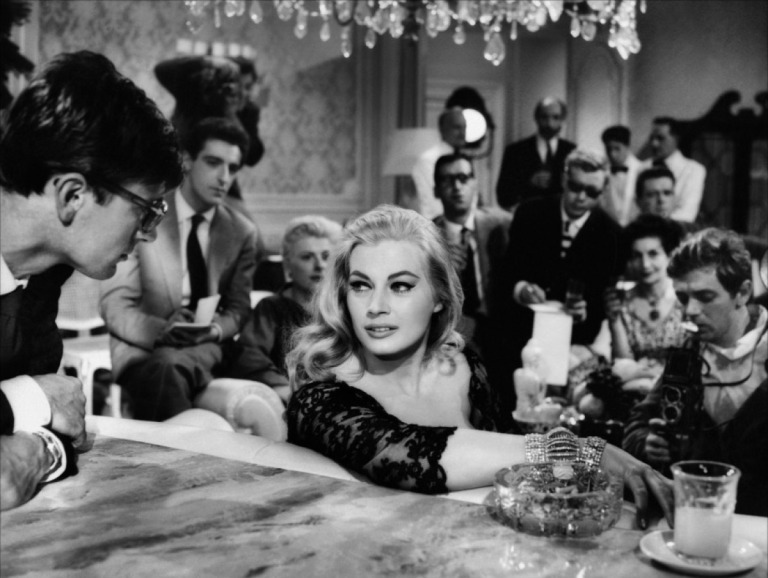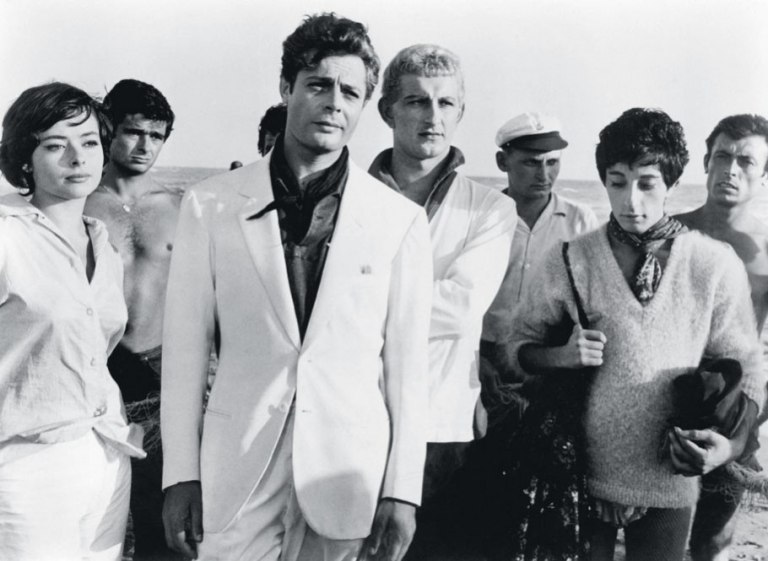This post is part of the Italian Film Culture Blogathon, organised by Nitrate Diva.
In La Dolce Vita (1960), Federico Fellini challenged, and indeed changed, perceptions of Italy’s public image. Favouring broad and expressive scenes, Fellini let the Rome ‘speak’ and – although much of what is depicted on screen is the result of an expensive set build – it was an authentic and gritty voice. The opening, aerial shots introduced the city and its historic landmarks like an energetic travel guide and the narrow streets and prostitute’s bedrooms took the viewer down to the people. This was post-WWII Italy, a country where a poverty and squalor could exist alongside a modern and vibrant culture, glitzy affluence and a new moral code that challenged the stranglehold of the Catholic Church.
However, La Dolce Vita wasn’t just important domestically. It put Italy, and Italian directors, back on the filmmaking map, winning the Palme d’Or at the 1960 Cannes Film Festival, and was nominated for four Academy Awards; Piero Gheradi winning for Best Costume Design (black and white). The film was also a commercial success, making $10m in its first year, and then a further $8m in America – more than any previous foreign films. Rome remains enamoured with its La Dolce Vita heyday. The city celebrated the film’s 50th anniversary with exhibitions and shows aplenty, with many film critics simultaneously praising and mourning the rapid modernisation and the subsequent loss of optimism that Rome experienced.
Fellini captured something of Italy that still resonates in the public and global perceptions of the country. The image of Anita Ekberg, lavishly enjoying the Trevi fountain, remains one of the most memorable scenes in film history. The dress that Ekberg wears – low-cut, with a sweetheart neckline and a layered overskirt with a contrast underlay – is the stuff of fashion lore. Interestingly, Fellini often claimed that designer Cristóbal Balenciaga’s sack dress inspired his vision for the film, although none of his dresses appear in the final film. According to co-writer Brunello Rondi, ”these sack dresses struck Fellini because they rendered a woman very gorgeous who could, instead, be a skeleton of squalor and solitude inside.’
If Ekberg was Fellini’s blonde and buxom (American) bombshell, Maddelena (played by Anouk Aimée) was his cool and elegant muse. Jaded and moody, she epitomises 1950s glamour and drifts through film in cat-eye shades and classic LBDs. Of course, the sunglasses are concealing a black eye but, by the time the audience is aware of this, Maddelena’s character is confirmed.
But for all of Ekberg’s lasciviousness and Aimée’s considered nonchalance, La Dolce Vita belongs to Marcello Rubini, played Marcello Mastroianni. Unusually for the period, Gheradi placed equal emphasis on the costumes for both the male and female leads; Mastroianni, a versatile actor, was the perfect choice to play a journalist whose character was underpinned by a unique style. Alluring and engaging, he pays attention to the detail, securing his double cuffs with cufflinks and, like Maddelena, understood the importance of dark sunglasses (Persol, if you’re interested).
The Marcello Rubini character was instrumental in creating the character we recognise as the ‘Latin Lover’. Casual, elegant and refined, Rubini is never without a stylish suit – tailored, single-breasted jackets with narrow trousers and immaculately pressed shirts – and stands apart from the paparazzi, who prefer wide-cut tweeds or sweaters and slacks. He stands in the shadows, aloof and observant, his masculinity, according to Stella Bruzzi, measured by narcissism ‘the smarter the clothes, the more dangerous the man, and the more damaged the clothes, the more vulnerable the man’
During the film’s closing scenes, Rubini wears a white suit and a black tie, a laidback take on traditional suiting that emphasises his increased vulnerability but serves to remind the audience that he is an intellectual journalist with the freedom to roam the city as and where he chooses. So successfully did Mastroianni own this character that it became inexorably wrapped up in his on-screen appearance and, according to the actor, led to casting directors and producers pigeonholing him as the ‘Latin Lover’.
Further reading: Fashion Cultures: Theories, Explorations and Analysis, edited by Stella Bruzzi and Pamela Church Gibson








I really need to take the time, perhaps on a lazy Sunday afternoon with a glass of limoncello in hand, and watch “La Dolce Vita”. I’ve always been intrigued by the look of the film, Mastraoianni’s detached swagger and Ekberg’s playful elegance. Great post.
That sounds like a perfect afternoon! Glad you enjoyed the post, and thanks for reading.
I will go back to this movie after reading your piece. Marcello Mastroianni’s easy charm was an ideal vehicle for portraying decadence. His nonchalant air was redolent with womanizing and sex. However this decadence was aloof. It rarely expressed itself in unabashed glee. A more likely expression was an amused shrug and resigned surrender to the demands of hedonism.
http://modernartists.blogspot.in/2012/03/marcello-mastroianni-seductive-look-at.html
Anita Ekberg ! The queen of Fontana di Trevi, Roma !
“Yes, here within thy sanctified walls there’s a soul in each object,
ROMA eternal. For me, only, are all things yet mute.
Who will then tell me in whispers and where must I find just the window
Where one day she’ll be glimpsed: creature who’ll scorch me with love?
Can’t I divine yet the paths through which over and over
To her and from her I’ll go, squandering valuable time?
Visiting churches and palaces, all of the ruins and the pillars,
I, a responsible man, profit from making this trip.
With my business accomplished, ah, then shall only one temple,
AMOR’s temple alone, take the initiate in.
Rome, thou art a whole world, it is true, and yet without love this
World would not be the world, Rome would cease to be Rome…”